Research Paper - (2011) Volume 19, Issue 1
Masters Candidate
Jeffery David Hughes BPharm Postgrad Dip Pharm MPharm PhD*
Professor, Head of School
Ya Ping Lee BPharm (Hons) PhD
LecturerRichard Parsons BSc MSc PhD
Senior Lecturer School of Pharmacy, Curtin University of Technology and Curtin Health Innovation and Research Institute, Perth, Australia
Received date: 26 May 2010; Accepted date: 19 December 2010
Background Recent studies have suggested that proton pump inhibitors (PPIs) may inhibit the antiplatelet activity of clopidogrel, increasing the risk of major cardiovascular events in patients taking clopidogrel and PPIs together. AimThe primary aim of this study was to determine the prevalence of co-prescription of clopidogrel and PPIs amongst residents of aged-care facilities in New South Wales, Australia. MethodsOne-year prescription records of 791 aged-care residents were analysed for prevalence of co-prescribing of clopidogrel and PPIs, and aspirin with clopidogrel and PPIs. Prevalence of co-prescribing of clopidogrel, aspirin and PPI in diabetic patients and clopidogrel with various CYP2C19 inhibitors were also examined. ResultsOf the 791 residents studied, 60 were prescribed clopidogrel, 248 were on aspirin and 326 were prescribed a PPI. Among residents who were prescribed PPIs, 155 were prescribed omeprazole, 72 pantoprazole, 15 lansoprazole, 44 esomeprazole and 51 rabeprazole. Eleven of these residents had taken more than one PPI during the study period. Thirty-nine residents took a combination of clopidogrel and a PPI (any PPI) for a mean 203 days (SD 12). Thirteen residents were on the combination of aspirin and clopidogrel for a mean of 202 days (SD 111). Nine residents took the combination of clopidogrel, aspirin and a PPI (any PPI) for a mean of 173 days (SD 81). Only one patient on clopidogrel was receiving a CYP2C19 inhibitor in addition to a PPI. ConclusionsA significant number of residents in this cohort were taking a combination of clopidogrel and a PPI, mainly omeprazole. Residents who were on the combination of clopidogrel and a PPI, with or without aspirin, were on these combinations for a significantly long duration, which could increase their risk of adverse cardiovascular events.
acute coronary syndrome, cardiovascular disease, clopidogrel, drug interaction, proton pump inhibitors
Clopidogrel is mainly indicated for the prevention of vascular ischaemic events in patients with symptomatic atherosclerosis, non-ST elevation acute coronary syndrome (ACS) (with aspirin) and, again with aspirin, as an adjuvant to reperfusion therapy for ST segment elevation myocardial infarction (MI).[1] Proton pump inhibitors (PPIs) are generally prescribed to patients taking aspirin and clopidogrel (both antiplatelet agents) as a prophylactic measure to prevent gastrointestinal (GI) tract bleeding. Gastrointestinal haemorrhage is more common in patients taking antiplatelet agents than in those taking a placebo. The risk of bleeding appears to be dose-dependent for aspirin and is increased by around 70% when aspirin is used in combination with clopidogrel.[2] This is particularly important in the elderly who are at increased risk both of gastrointestinal bleeding from long-term aspirin use and of serious adverse outcomes. Straube et al[3] reported that mortality associated with gastrointestinal haemorrhage and perforation is about one in five for those patients exposed to aspirin or non-steroidal anti-inflammatory drugs (NSAIDs). Fortunately the concomitant use of PPIs with antiplatelet agents reduces the incidence of gastrointestinal bleeding, and it has therefore been recommended that PPIs be used in patients with risk factors for upper GI bleeding treated with dual antiplatelet therapy.[4] However, recent studies have suggested that PPIs may inhibit the antiplatelet activity of clopidogrel, resulting in an increased risk of major cardiovascular events in patients taking this combination following an ACS.[5,6] Clopidogrel is a prodrug activated in the liver to form a thiol metabolite that is a specific and irreversible inhibitor of platelet P2Y12 ADP receptor and inhibits platelet aggregation.[7] This bioactivation is mediated by hepatic cytochrome P450 isoenzymes, with cytochrome P450 2C19 (CYP2C19) and cytochrome P450 3A4 (CYP3A4) playing major roles.[6] The genes encoding CYP2C19 are polymorphic and patients with reduced function CYP2C19 allele have lower levels of active metabolite of clopidogrel. The carriers of this allele are twice as likely to die from MI or stroke compared with non-carriers and have a three times increased risk of stent thrombosis due to diminished platelet inhibition relative to those without such polymorphisms. [7–9] PPIs are also metabolised by CYP2C19 to varying degrees.[10] Evidence suggests that some PPIs can inhibit CYP2C19 and hence inhibit the bioactivation of clopidogrel.[5] The randomised double blind OCLA(OmeprazoleClopidogrelAspirin) study[5] showed that omeprazole significantly decreased clopidogrel’s inhibitory effect on platelet P2Y12 as assessed by the vasodilator-stimulated phosphoprotein (VASP). The finding of this study was consistent with a previous observational study which showed that patients using PPIs with a combination of clopidogrel and aspirin had significantly higher VASP values than non-users of PPIs.[11] VASP phosphorylation in human platelets correlates with platelet aggregation and there is a direct link between VASP and major adverse cardiac events.[12]
A retrospective cohort study in patients taking clopidogrel with or without a PPI after hospitalisation for ACS reported that use of clopidogrel with a PPI was associated with an increased risk of death or rehospitalisation for ACS compared with use of clopidogrel without a PPI.[13] Approximately 60% of patients that took a PPI medication in this study were prescribed omeprazole.
A population based nested case-control study in 13 636 patients (734 cases and 2057 controls) reported that in patients taking clopidogrel following an acute MI, concurrent use of a PPI was associated with increased risk of reinfarction (OR 1.27, 95% CI 1.03–1.57).[6] Pantoprazole, which does not inhibit CYP2C19, was shown to have no association with readmission for MI.
In contrast to the reported negative omeprazole– clopidogrel drug interaction, a mechanistic study10 conducted in 300 coronary artery disease (CAD) patients undergoing percutaneous coronary intervention (PCI) indicated that intake of pantoprazole or esomeprazole was not associated with impaired response to clopidogrel as assessed by VASP assay and aggregometry. Similarly, a pharmacokinetic study in healthy subjects showed that lansoprazole did not alter the antiplatelet activity of clopidogrel measured as inhibition of platelet aggregation (IPA).[14]
The COGENT trial is the only randomised doubleblind, placebo-control trial to have examined the potential interaction between clopidogrel and omeprazole with cardiovascular (CV) events as the outcome.[15] In this study 3761 patients with either ACS or PCI were randomised to a fixed-dose combination of clopidogrel and omeprazole (75/20 mg) or clopidogrel alone, in addition to low dose aspirin. There was no significant difference in a composite CV endpoint (MI, stroke, coronary artery bypass graft, PCI, CV death) for patients on the fixed-dose combination compared with clopidogrel alone (HR: 0.99; 95% CI: 0.68 to 1.44), but there were fewer GI adverse events (HR: 0.34; 95% CI: 0.18 to 0.63).[15] However, the study findings have been questioned as the planned enrolment and follow-up were curtailed due to financial problems of the trial sponsor, and the rate of CV events in both groups was low (55 versus 54 CV events). The broad confidence interval for CV events does not exclude the possibility of a clinically important increase in risk of up to 44%.[16]
CYP2C19 does not appear to be a major metabolic pathway for clopidogrel metabolism with evidence suggesting that CYP3A4 is a major contributor of clopidogrel active metabolite generation. Lau et al reported that atorvastatin reduces platelet inhibition by clopidogrel due to competitive inhibition of CYP3A4 substrate in a dose dependant manner.[17] CYP3A4 stimulators rifampin and St John’s Wort enhanced platelet inhibition by clopidogrel, whereas agents that compete with clopidogrel for CYP3A4 (e.g. erythromycin) attenuated platelet inhibition. It is known that ageing affects drug metabolism, and that in older adults CYP content declines and antipyrine (a specific CYP substrate) clearance also declines.[18] The ramifications of this on the potential interaction between clopidogrel and PPIs is at this time unknown.
The study was approved by the Curtin University Human Research Ethics Committee. We studied the prescription records of 791 residents of residential aged-care facilities (i.e. nursing hostels and nursing homes) for prevalence of co-prescribing of clopidogrel and PPIs, and aspirin with clopidogrel and PPIs. The data file consisted of 65 259 records of drugs prescribed over the course of a year (from 2 January 2007 to 31 December 2007). We also studied the prevalence of co-prescribing of clopidogrel with various CYP2C19 inhibitors. The prevalence of co-prescribing of aspirin, clopidogrel and PPIs in residents with diabetes was also determined, as they are at high risk of cardiovascular disease and more likely to be on this combination.
PPIs included in the analysis were omeprazole, pantoprazole, lansoprazole, esomeprazole and rabeprazole. The CYP2C19 inhibitors included were cimetidine, efavirenz, fluoxetine, fluvoxamine, indomethacin, ketoconazole, modafinil, oxcarbazepine, ticlopidine, topiramate and voriconazole. We classified residents as diabetic if they were on any of the following anti-diabetic drugs, namely insulin, metformin, glibenclamide, gliclazide, glimepiride, glipizide, pioglitazone, rosiglitazone, acarbose and repaglinide, at any time during the study period.
Prescribing data were sourced for 1000 aged-care residents from Webstercare Pty Ltd, a supplier of pharmacy services to numerous residential aged-care facilities in New South Wales, Australia. The data file consisted of de-identified records of all prescribed medicines for the random sample of aged-care residents during 2007. It consisted of the following fields: resident’s date of birth, gender, drug name, dose, dispensed date, date of commencement and the last date of taking the drug. Each patient was assigned a unique code number. Based on a review of the data provided complete records were available for 791 residents, and these were used in the subsequent analysis. A person-based analysis was performed. Each person having the various available combinations of drugs and the duration for which they had been on the combination therapy were determined. This was to ascertain that the patients used the combination of drugs concurrently and not at different periods. The number of days a patient was on a drug or combination of drugs was calculated by dividing quantity of drug dispensed by dose per day.
The data file was provided as a Microsoft Excel1 spreadsheet but was transferred into DBF format for statistical analysis. The SAS statistical software program was used to obtain tables of the mean, standard deviations and median number of days when the different combinations of drugs were taken. The DOS-based CLIPPER database program was used to calculate drug frequencies and identify the dates when each type of drugwas taken, and from that the number of days for each combination of drugs taken.
Voluntarily reported case reports of adverse cardiovascular events due to the use of the combination of clopidogrel and PPI, and aspirin with clopidogrel and PPI, were also obtained from ADRAC (Adverse Drug Reactions Advisory Committee) for the period up until July 2009. ADRAC monitors drug safety in Australia and these reports were sought in order to identify the number of adverse cardiovascular events and whether PPI was implicated, in order to identify any patterns.
The data file consisted of records of 791 selected agedcare residents with a mean age of 90 years (SD 12.1). There were 585 female residents with a mean age of 91 years (SD 11.1) and 206 male residents with a mean age of 87 years (SD 12.5).
Of 791 residents, 60 were prescribed clopidogrel, 248 were prescribed aspirin and 326 were prescribed a PPI (any PPI) (Table 1). Among residents who were on PPIs, 155 were on omeprazole, 72 on pantoprazole, 15 on lansoprazole, 44 on esomeprazole and 51 on rabeprazole. Eleven of these residents had taken more than one PPI during the study period.
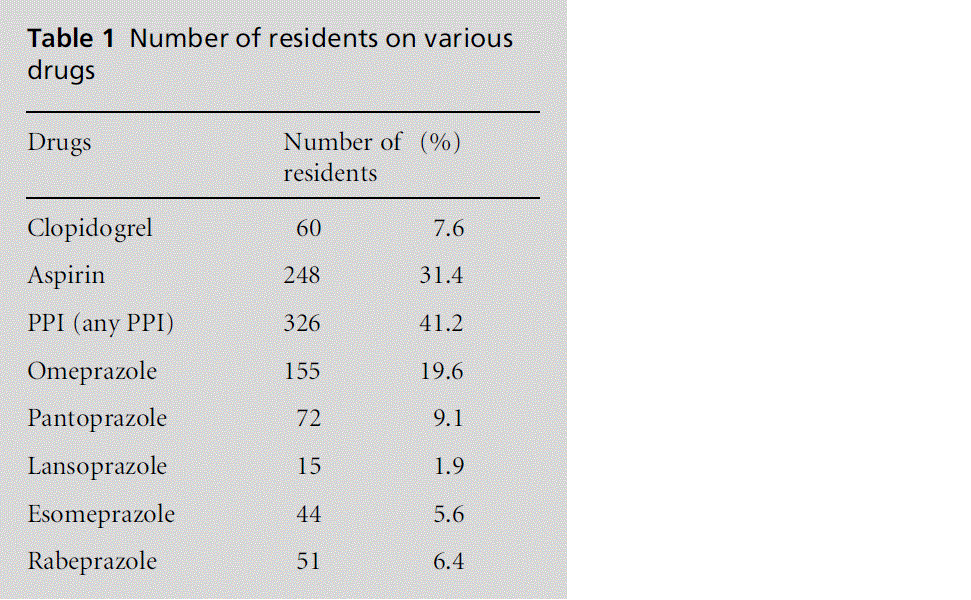
Thirty-nine residents were on the combination of clopidogrel and a PPI (any PPI) for a mean of 202.9 days (SD 11.5). Of the 39 people on clopidogrel and a PPI, 18 residents were on omeprazole, nine on rabeprazole, seven on esomeprazole, six on pantoprazole and one on lansoprazole (Table 2).
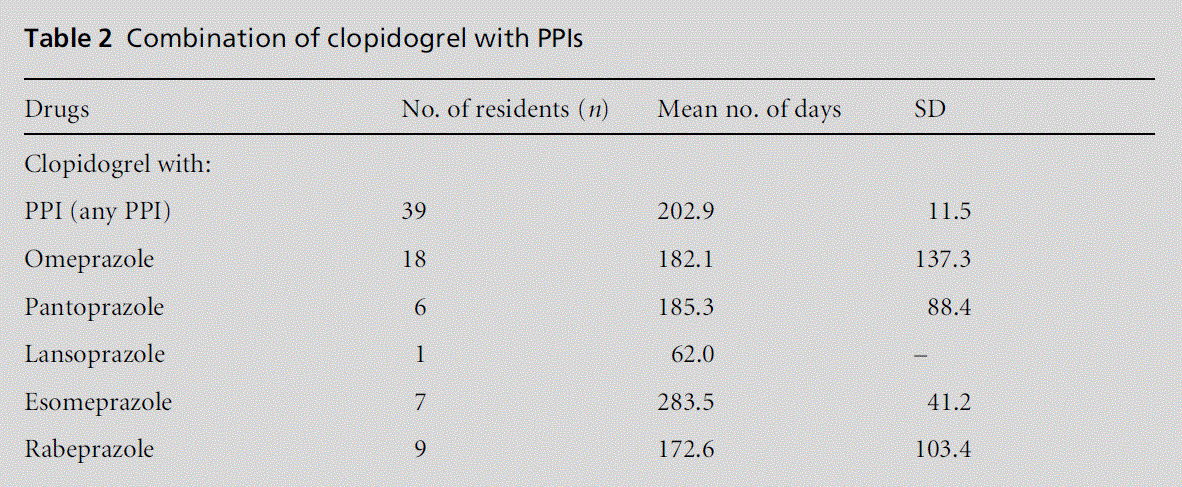
Thirteen residents were on a combination of aspirin and clopidogrel for the mean of 202.3 days (SD 111.1). Nine residents took the combination of clopidogrel, aspirin and a PPI (any PPI) for a mean of 203.1 days (SD 81). Among patients taking aspirin, clopidogrel and PPI, six were on omeprazole for a mean of 222.2 days (SD 76.9) and three patients were on rabeprazole for a mean if 165 days (SD 90.6) (Table 3).
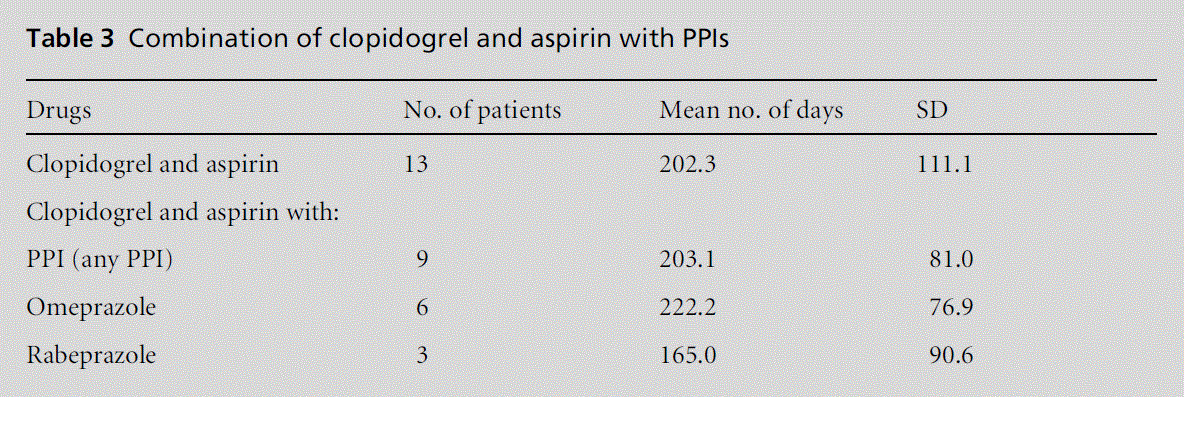
The co-administration of clopidogrel with another CYP2C19 inhibitor was only observed in one resident who took a combination of fluoxetine and clopidogrel for 29 days. Five diabetic patients were on the combination of clopidogrel and a PPI (any PPI) for a mean of 206.4 days (SD 105.8), with three residents on pantoprazole, one on omeprazole and one on esomeprazole
(Table 4). Only one resident with diabetes in this cohort was taking a combination of aspirin, clopidogrel and omeprazole for 151 days (Table 5).
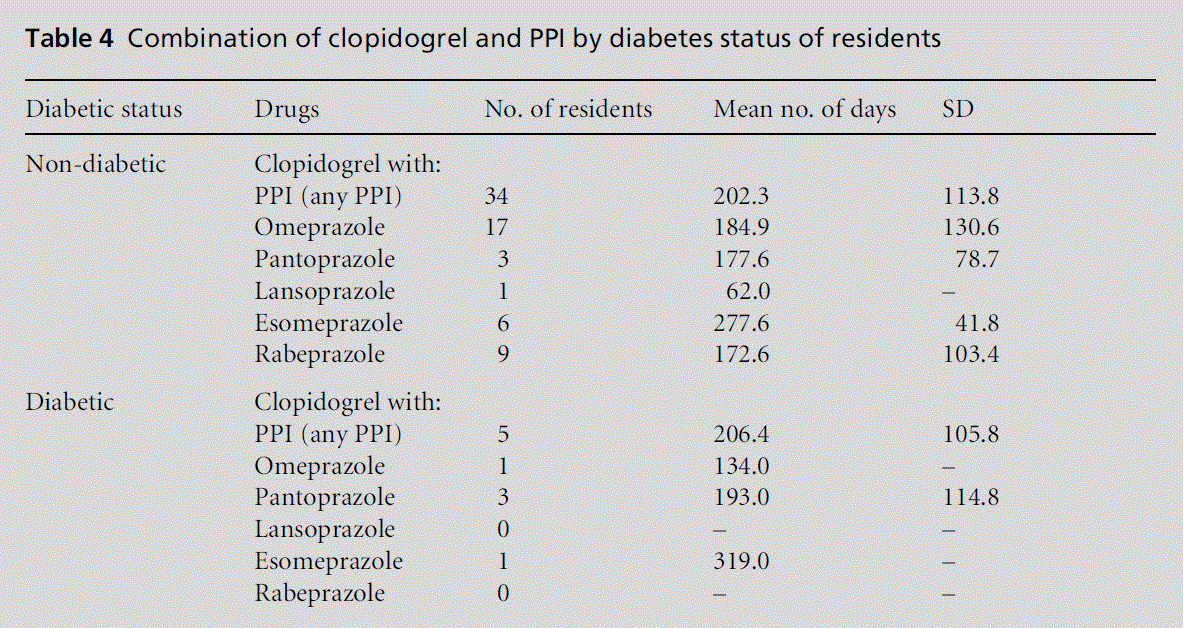
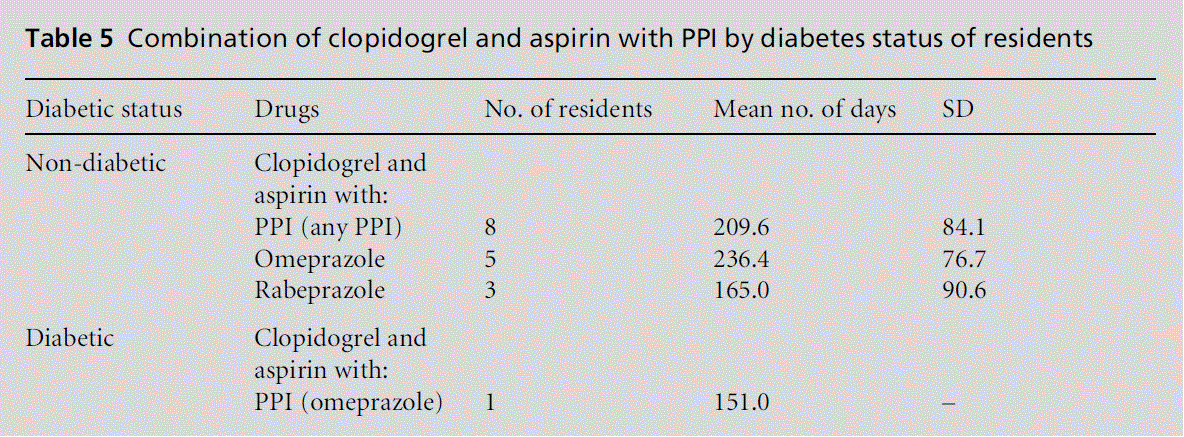
One case report on an adverse cardiovascular event was obtained from ADRAC regarding the combination of aspirin, clopidogrel and PPI. The case was reported in December 2008 and involved a 76-year-old male patient who was on the combination of aspirin, clopidogrel and omeprazole. He suffered bradycardia and coronary artery occlusion reported as a result of the drugs being ineffective.
Clopidogrel is one of the highest selling drugs in the world. In 2003, 1.3 million Pharmaceutical Benefit Scheme (PBS) prescriptions for clopidogrel were dispensed in Australia.[19] Clopidogrel supply has rapidly increased in Australia since its introduction, from 1.2 to 9.0 defined daily doses (DDD) per 1000 population per day. The DDD per thousand population per day shows how many people, in every thousand patients, are taking the standard dose of a drug every day. Between 30% and 73% of clopidogrel supply was accounted for by people receiving cardiac stents.[20] PPIs are also one of the most frequently prescribed classes of drug in the world, resulting in expenditure of approximately 14.3 billion US dollars globally in the year 2006 alone.[21] In Australia 4.42 million PBS prescriptions for esomeprazole and 3.88 million prescription for omeprazole were dispensed in the year 2006 to 2007, making them the third and fourth respectively most prescribed subsidised drugs in that year.[22] Recent guidelines from the American Heart Association, the American College of Gastroenterology and the American College of Cardiology recommend a PPI for many patients receiving aspirin following a heart attack.[4] Clopidogrel and aspirin are often prescribed together for patients treated either medically or with PCI following a heart attack. It is likely that millions of patients worldwide will take the combination of clopidogrel and a PPI. Considering the widespread use of these medications, it becomes important to further research the interaction between these drugs.
A significant association was reported between clopidogrel and PPIs suggesting that their concomitant use may lead to attenuation of the benefits of clopidogrel, leading to adverse cardiac outcomes.[13] A randomised controlled trial showed that omeprazole significantly decreased clopidogrel’s inhibitory effect on platelet P2Y12 ADP receptor. Depending on the exposure to these drugs following a heart attack, it was estimated that between five and 15% of early readmissions for MI among patients taking clopidogrel could be the result of this drug interaction.6 Studies show that longer duration of treatment with clopidogrel plus PPIwas associated with adverse outcomes.[6,17] Our study showed that residents who were on combination of clopidogrel and PPI, with or without aspirin, were on these combinations for a significantly long duration (a mean of 202 days a year).
It is also important to assess if inhibition of clopidogrel action by PPIs is a drug effect or class effect. The reported negative effects of omeprazole on clopidogrel function was not seen in patients treated with pantoprazole, esomeprazole and lansoprazole.[10,14] However, there was no study done to directly compare the effects of different PPIs on clopidogrel function. Evidence suggests that omeprazole is most likely to decrease the anti-platelet activity of clopidogrel, possibly due to inhibition of the CYP2C19 enzyme.[6,13] In our study, 155 out of 326 (47%) of patients who were taking PPI were on omeprazole. The only case report available from ADRAC involved omeprazole. Omeprazole was the first generic PPI, introduced in 2002, and still comprises majority of prescriptions for PPIs since its introduction.[21] The adverse outcomes reported with omeprazole could be associated with its widespread use compared with other PPIs. This appears to be supported by the results of the COGENT trial, which failed to demonstrate any difference in adverse CV outcomes amongst clopidogrel users taking omeprazole compared with those who were not.[15]
Several studies have demonstrated that CYP2C19 gene polymorphism is associated with greater clopidogrel non-response and an increased risk of adverse cardiovascular events.[7,9] Some studies showed that as many as 30% of people worldwide are born with this particular genetic variation.[9]The way PPIs interfere with the conversion of clopidogrel to an active form may mimic this genetic variation, which produces lower amounts of the enzyme. Individuals with this polymorphism can be at an increased risk of thrombosis and this risk is further aggravated if they take a combination of clopidogrel with PPIs. Taking this genetic variation into account, Bonello et al[12] showed that adjusting the clopidogrel dose individually in patients according to their VASP index, before PCI, in daily clinical practice improved the clinical outcome after coronary stenting. Personalised medicine might also lead to determining the genetic status of an individual patient – if one is a high responder or low responder to clopidogrel – and allow adjustment of treatment accordingly.
The US Food and Drug Administration has released a communication about the safety review of potential interaction between clopidogrel and PPIs.[23] The FDA highlighted the need for additional studies to evaluate the effectiveness of clopidogrel when used concurrently with PPIs. Until further information is available the FDA issue the following advice:[23]
•Avoid using omeprazole and clopidogrel together and at any time of the day.
•Avoid using other potent CYP2C19 inhibitors, including esomeprazole, with clopidogrel.
•FDA does not have enough evidence to preclude the use of other PPIs other than omeprazole and esomeprazole.
•Patients taking clopidogrel should consult with their healthcare provider if they are currently taking or considering taking a PPI.
Patients who use clopidogrel and need amedication to reduce stomach acid can use antacids, ranitidine, famotidine or nizatidine, but not cimetidine. However, in the ACCF/ACG/AHA 2010 Expert Consensus Document on the concomitant use of PPIs and thienopyridines mention is made of the need to balance bleeding risk against cardiovascular risk.16 The authors of this document suggested that the concurrent use of PPIs with clopidogrel may be justifiable in patients with risk factors for gastrointestinal bleeding, including a prior history of GI bleeding, advanced age, concurrent use of warfarin, NSAIDs or corticosteroids and Helicobacter pylori infection, due to the substantial reduction in bleeding risk.
A significant number of aged-care residents in this cohort were taking the combination of clopidogrel and a PPI. Almost 50% of the residents who were on PPIs were prescribed omeprazole. Residents on the combination of clopidogrel and a PPI, with orwithout aspirin, were on these combinations for a significantly long duration, which significantly increased the risk of adverse cardiac events. This drug interaction is now evident and it is necessary to review the coadministration of clopidogrel with PPIs (especially omeprazole and esomeprazole) in this group to prevent an adverse outcome.Whilst the use of a PPI could be justified based on the advanced age of the residents in this study, the risk of adverse cardiac events needs also to be considered when making the decision to continue the combination. The clinical impact of these results must be assessed by further studies comparing cardiovascular outcomes for patients taking clopidogrel plus PPI versus clopidogrel without PPI, and comparing the impact of different PPIs on the effectiveness of clopidogrel.
This study received no Funding from any source.
The study was approved by the Curtin University Human Research Ethics Committee.
Not commissioned; externally Peer Reviewed.
None.
We would like to thank Gerard Stevens (Managing director, Webstercare Pty Ltd) for provision of the dispensing data.